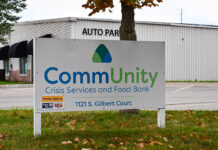
Investment trends in the U.S. commercial real estate market remain positive, Aegon Asset Management Co-Head of Real Estate Scott Coté said during his keynote address at the CBJ’s Commercial Real Estate Luncheon on Sept. 13.
By Dave DeWitte
[email protected]
Despite commercial real estate sales, and even some prices, hitting new highs, Aegon Asset Management’s Scott Coté told attendees at the CBJ’s 2016 Commercial Real Estate Luncheon that he believes the upward cycle has yet to run its course.
“Rents have been increasing, vacancy rates falling and capitalization rates are at all-time lows, but still offer a relatively healthy spread over the risk-free rate,” Mr. Coté said during the keynote presentation at the Sept. 13 event. “We’ve reached basically the same peak values of 2007 in transaction volumes.”
Capitalization rates are a key measure of return on real estate investment – essentially the net income of a property in a given year divided by its market value. Mr. Coté said cap rates, while low, are better than risk-free investments like treasury bills as central banks around the globe hold interest rates low to try to stimulate their economies.
The margin between cap rates in the U.S. and returns on one benchmark “risk-free” rate, the 10-year treasury bill, now stands at a healthy 300-425 basis points, or 3-4.25 percent, Mr. Coté said.
“Non-U.S. investors are coming to the states and saying that looks pretty good,” he noted.
Mr. Coté brought a global perspective to the annual real estate event, held at The Hotel at Kirkwood in Cedar Rapids. He is co-head of real estate for Aegon Asset Management, a division of Netherlands-based insurance giant Aegon that manages $18 billion of commercial real estate assets for both Aegon’s Transamerica division and nonaffiliated clients. Most of the division’s clients are in commercial mortgage and agricultural loans, and equity in affordable housing.
Foreign capital flows into U.S. commercial real estate climbed from about $10 billion in 2009 to more than $90 billion in 2015, Mr. Coté said. In one year alone, from 2014 to 2015, foreign capital flows into industrial real estate roughly quadrupled, to $28 billion. About 70 percent of those inflows went into just 10 large metro real estate markets, Mr. Coté said.
Compared to their lows following the market crash of 2008, “Apartments are up 66 percent – a head scratcher,” he said. “We still like apartments. We’re pretty bullish on them.”
Demand for apartments has been driven by disproportionate growth in the age segments that prefer to live in apartments – adults ages 20-30 and over 60, Mr. Coté said. High barriers to homeownership have also driven demand, including student loan debt, a low inventory of single-family homes and difficulty obtaining credit.
Even though prices have gone up so much, Mr. Coté said oversupply risks seem to be limited to a handful of central business districts and core urban areas.
During the same peak-to-peak period, office real estate prices climbed 13.4 percent, industrial prices climbed 7.5 percent and retail real estate prices didn’t climb at all.
Mr. Coté said he’s nervous about trends in the retail sector. He pointed to a chart showing that the gap in retail sales per square foot between brick-and-mortar retail stores and overall sales (including online sales) has widened considerably since 2009, and continues to widen.
Large U.S. retailers are increasing their online presence, reducing store space and making other changes in their business models to respond to the online trend, Mr. Coté said. In the latest threat to the brick-and-mortar retail model, online grocers are offering home delivery of foods shipped from large distribution centers with much lower overhead than traditional stores.
While offering a generally bullish case for commercial real estate investing, Mr. Coté acknowledged that he’s often asked why investing in commercial real estate now is any different than it would have been at the last market peak in 2007, just before the market plummeted.
“Today we see a lot of restraint in the market, especially with bankers,” Mr. Coté said. Regulation has played a big part in that, he said, with the Dodd-Frank Wall Street Reform Act, in particular, reducing lending excesses in new development. Most real estate investors today are interested in holding onto their investments rather than “spinning” them for a quick profit, he added, and consumers are not as financially overextended as they were in 2007.
While a lot seems to be riding on low interest rates, Mr. Coté said he sees “no end in sight” to the overall low interest rate environment that could stall the commercial real estate market.
Aegon Asset Management is separate from Transamerica, the company’s U.S. financial services business that employs more than 3,000 in Cedar Rapids.
Mr. Coté said Aegon owns a significant amount of real estate in the Corridor, but hasn’t done a lot of real estate lending here. The recent decision by Transamerica to put its Edgewood Road campus in northern Cedar Rapids on the market and consolidate at the Transamerica Financial Park on C Avenue SW is something he’s been asked about. Mr. Coté said he wasn’t involved in the decision, and could only interpret it as a move to improve efficiency by consolidating employees from two locations to one.
The Sept. 13 luncheon drew more than 320 attendees, and was sponsored by commercial real estate specialists GLD Commercial, the city of North Liberty and Shive-Hattery. Ahmann Companies and Cook Appraisal were supporting sponsors.





